Yes, but back around 1906 when they were moving earth for the dam on Reservoir #1 or as it is now known Chestermere Lake. The full provenance of that tooth is a mystery, it may have made its way into a collection at the Calgary Zoo but no one is sure. Another was also found on the west shore in 1973. http://www.nrcresearchpress.com/doi/pdf/10.1139/e78-134 How exciting to imagine 11 foot (3m) tall, 6 ton Mammuthus primigenius roaming our city footprint. So thought the children who were mesmerized by the collection of animals and birds, mammoths included, that Cory Gross, author and science educator from Glenbow Museum, showed the kids on Saturday November 24th at the Chestermere Library at the Prehistoric Chestermere presentation sponsored by the Chestermere Historical Foundation. To quote Cory,
“About 100,000 years ago, Western Canada would have seemed at first glance to be very similar to today. Alberta’s landscape would be shaped by rolling hills of soil-covered glacial till, wide coulees that once drained proglacial lakes, and an occasional ridge of sandstone jutting from the prairie floor as a remnant of even more distant times. Yet as familiar as it might have been, Western Canada would have been markedly different in many ways. Alongside familiar animals like coyotes, prairie dogs, Canada geese, beavers, cougars, deer, chickadees, and buffalo would have been mammoths, giant sloths, sabre-tooth cats, American lions, mastodons, short-faced bears standing six feet tall at the shoulder, and giant beavers the size of black bears.
“It is difficult to determine exactly what caused the extinction of ice age animals 11,700 years ago. Many changes were happening at once – climate, sea level, vegetation, invasive species, human migration, and an asteroid impact – and different species react to these changes in different ways. A likely scenario is that a combination of environmental stresses and human hunting set-up a cascade of changes from which ice age megafauna could not recover. This has dire implications for our modern world with its own rapid climate fluctuations and large-scale human activities.”
So many thousands of years ago, and we still have many of those remaining creatures right here in our city–coyotes Canada Gees for example. Happily, no giant beavers! Should you wish to read more about this Cory has written the introductory chapter for ‘ In the Footsteps of Giants’ published by the Chinook Country Historical Society and this book is available at Chestermere Library.
Watch for future programs from the Historical Foundation, starting in January 2019 the third Tuesday at Chestermere Library, on a variety of topics about our local history. And a play about the history of Chestermere being written right now to be performed 25 August 2019 in John Peake Park Pavilion. Go to www.chestermerehistoricalfoundation.org
Woolly Mammoth Teeth Found in Chestermere

In response to Canada's Online News Act and Meta (Facebook and Instagram) removing access to Canada's local news from their platforms, Anchor Media Inc encourages you to get your news directly from your trusted source by bookmarking this site and downloading the Rogue Radio App. Send your news tips, story ideas, pictures, and videos to info@anchormedia.ca.







